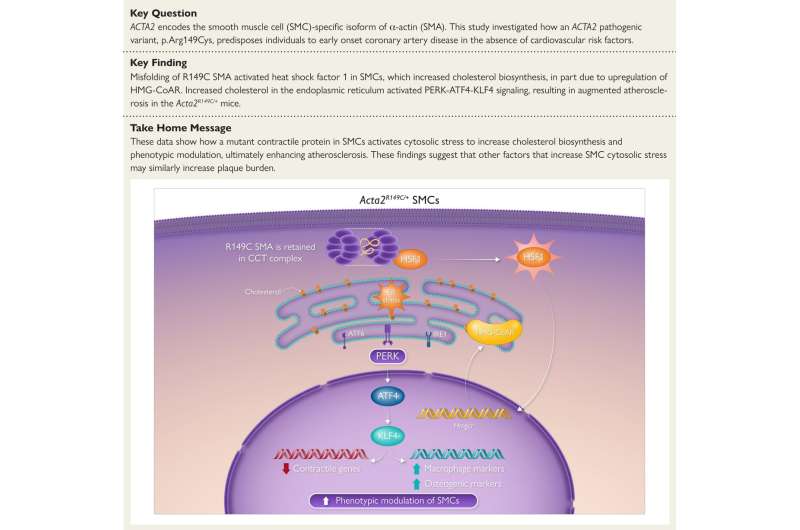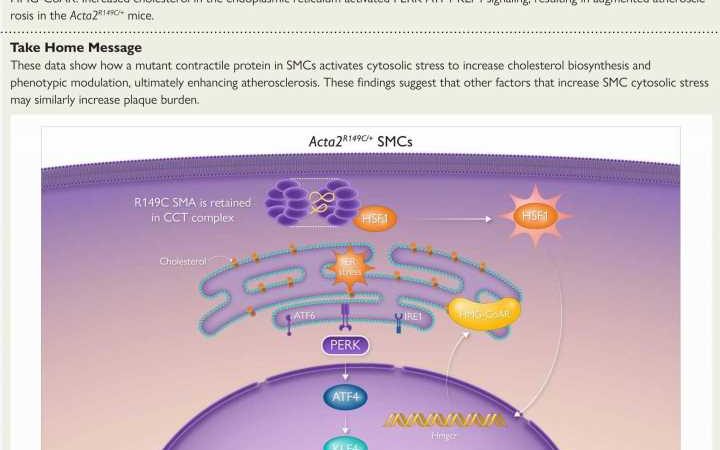
A novel molecular pathway to explain how a mutation in the gene ACTA2 can cause individuals in their 30s—with normal cholesterol levels and no other risk factors—to develop coronary artery disease has been identified, according to researchers with UTHealth Houston.
The study was published in the European Heart Journal.
“The gene ACTA2 codes a specific protein that has nothing to do with cholesterol,” said Dianna Milewicz, MD, Ph.D., senior author of the study and professor and director of the Division of Medical Genetics at McGovern Medical School at UTHealth Houston. “It was a surprise to find that people with the gene mutation had too much atherosclerosis at a young age and with no risk factors.”
A 2009 study led by Milewicz found that a number of mutations in ACTA2 predispose humans to develop early onset (30s or younger) coronary artery disease.
Atherosclerosis is a buildup of fats, cholesterol, and other substances in and on the artery walls. It can develop over time and most people don’t know they have it until they suffer a heart attack or stroke. Traditional risk factors for developing atherosclerosis include high cholesterol, high blood pressure, diabetes, smoking, obesity, lack of exercise, and consuming a high-fat diet.
ACTA2 is typically found in the smooth muscle cells, which line the arteries and allow the arteries to contract to control blood pressure and flow. Milewicz and her team found that protein coded by this gene is not folded correctly because of the mutation, and it triggers stress in the smooth muscle cell, which then forces the cell to make more cholesterol internally, regardless of the levels of cholesterol in the blood, driving atherosclerotic plaque formation.
“This finding is unique in that we found a completely new pathway to atherosclerosis. It explains why for years we have known statins protect people from heart attacks, even those people whose blood cholesterol levels are normal. In the people with ACTA2 mutations, the statins block the cholesterol made by the stressed smooth muscle cells,” said Milewicz, the President George Bush Chair in Cardiovascular Medicine with McGovern Medical School.
“In our study, the mutant protein made by the ACTA2 mutation caused the cells in the artery wall to be stressed, but there are many other factors that can stress cells. We are now working on the risk factors for coronary artery disease, like hypertension, that would also stress the cells and activate this novel pathway for coronary artery disease.”
One of the results of stress in smooth muscle cells associated with atherosclerosis is the deposition of calcium in the arteries.
“Cardiac calcium imaging in individuals with ACTA2 mutations could be a useful early diagnostic tool to monitor the development of the early atherosclerosis in these people. This would allow physicians to decide at what age to start these patients on statins,” Milewicz said.
Using a genetically engineered mouse that contains a particular ACTA2 mutation and feeding the mice a diet rich in cholesterol, the researchers induced atherosclerosis and found that these mice have much more atherosclerosis than similarly treated mice normal mice.
The study also found that the increased atherosclerosis could be reversed by treating the mice with pravastatin, a member of the statin group of drugs commonly prescribed to lower blood cholesterol. The researchers confirmed that same molecular pathway is activated in smooth muscles cells isolated from a human patient with an ACTA2 mutation.
Statins prevent coronary artery disease by lowering the levels of cholesterol in the blood. At the same time, more than half of heart attacks occur in apparently healthy men and women with average or low levels of plasma LDL-cholesterol. Statins also reduce heart attack events in people with normal cholesterol levels.
More information:
Kaveeta Kaw et al, Smooth muscle α-actin missense variant promotes atherosclerosis through modulation of intracellular cholesterol in smooth muscle cells, European Heart Journal (2023). DOI: 10.1093/eurheartj/ehad373
Journal information:
European Heart Journal
Source: Read Full Article
